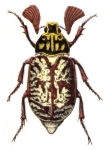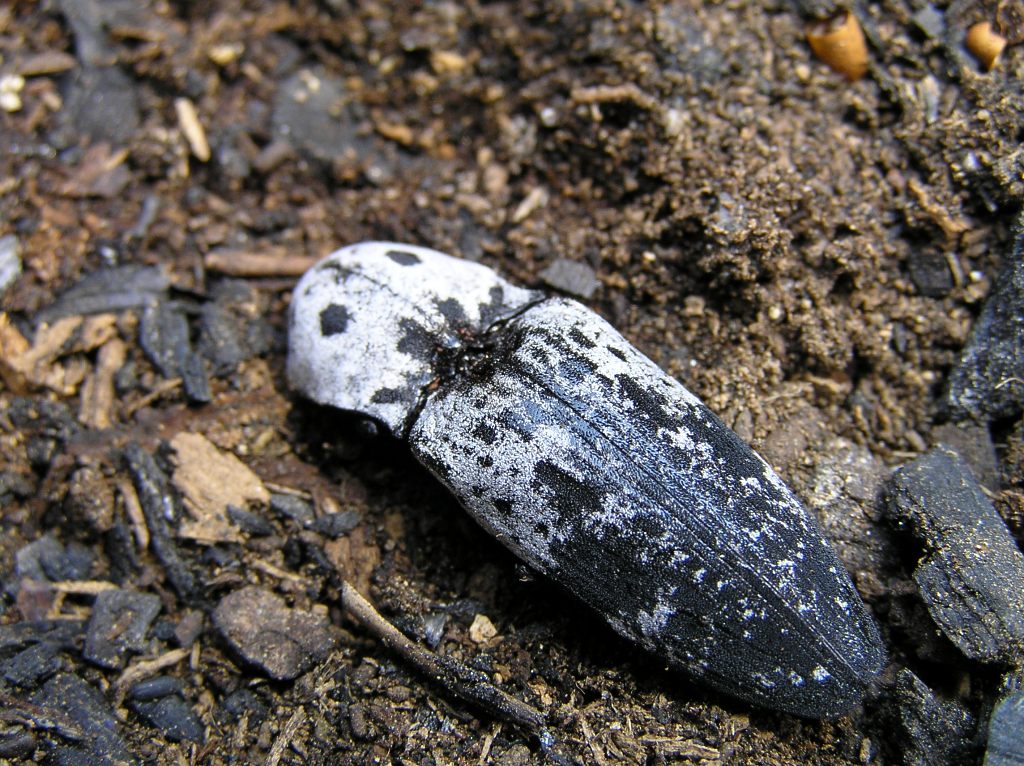|
Description / Habitats / Flora / Vertebrates / Insects / Invertebrates / What's that Bug? Home / Nestos Delta / Bibliography / About this site / Links / Contents / Galleries ____________________________________________________________________________ |
|
__________________________________________________________________________________________________________ THE CLICK BEETLES (COL., ELATERIDAE & EUCNEMIDAE) OF THÁSOS Click beetles (Elateridae) belong to the Superfamily Elateroidea, which also contains the fireflies, net-winged beetles and soldier beetles as well as the false click beetles (Eucnemidae). Most species have a characteristic narrow, elongate appearance and all of the true click beetles have the ability to propel themselves into the air by 'clicking' a spine on the underside of their body. This enables them to escape from predators and also helps to right themselves when the beetle falls onto its back. Most click beetles develop as larvae within the soil and feed on plant roots and dead material, with their larvae known as wireworms because of their long, cylindrical shape. Other species occur within dead and dying trees where they predate other invertebrates as well as feeding on the decaying wood. Most click beetles are inconspicuous and likely to be overlooked by the general visitor but in Spring some species can be abundant on hawthorn Crataegus monogyna blossom, especially Cardiophorus discicollis in which the female has a distinctive black and red pronotum. The most striking species on the island is the large saproxylic species Calais parreysii (the biggest European click beetle reaching up to 4 cms in length), which is not uncommon underneath the bark of fallen pine trees. It is an eastern Mediterranean species that is listed as Near Threatened by the IUCN (Nardi, G. et al. 2010; Nieto & Alexander 2010), but that assessment is based on just three records from the Greek mainland and it would be surprising if it was not more widespread in the country. The Red List account mentions that it is associated with old pines growing in humid environments near to streams etc., but that is not my experience on Thásos where I have found it from sea level to the mountain summits in red-rotten pines in very dry, exposed situations.
The click beetle Ampedus elegantulus is categorised as Near Threatened in Europe and the false click beetle Farsus dubius is similarly listed as Near Threatened in Europe but is accorded Vulnerable status in the European Union. The elaterid fauna of Greece is large and imperfectly known. Oertzen (1886) listed 93 species of Elateridae for Greece but, in contrast, Mertlik (2008) lists 451 species from neighbouring Turkey. The richness of the fauna in Greece is demonstrated by the fact that 66 elaterid species were collected during a two-week collecting trip by staff from the Hungarian Museum of Natural History in May 2011. In recent years there have been numerous additions to the Greek fauna through the work of Giuseppe Platia and others, and it can be expected that further species will be recognised in the future. So far a mere twenty-four elaterid species and a single eucnemid, Farsus dubius, have been recorded from Thásos. As with so many insect groups, Karnozickij (1959) provided the first records from the island with four species recorded in surveys during 1942 and 1943. The only other published records I know of are those of M. & T. Cerruti (Guglielmi & Platia, 1985) who recorded seven species in May 1973, four of which were new to Thásos. My visits to the island resulted in records of seven of the eight previously reported species (Peripontius terminatus was not seen) and the addition of a further seventeen species, asterisked in the Checklist below.
I am grateful to Howard Mendel and Paul Whitehead for help with identification and to Dave Boyce for assistance with collecting on Thásos in May 1997.
CHECKLIST Elateridae
Adrastus rachifer
* Calais parreysii (Steven, 1829)
Eucnemidae
REFERENCES
Nardi, G. et al. 2010. Calais parreysii. The IUCN Red List of Threatened Species 2010: e.T157539A5091594. Guglielmi, A. & Platia, G. 1985. Contributo alla conoscenza degli Elateridi di Grecia e Turchia (Coleoptera). Fragmenta Entomologica, 18: 169-224 Karnozickij, N. 1959. Materialien zur Koleopteren-Fauna der Agäischen Küste und Insel Thasos. Izv. zool. Inst. Sof., 8: 237-253. Mertlik, J. & Platia, G. 2008. Catalogue of the family Cebrionidae, Elateridae, Lissomidae, Melasidae and Throscidae (Coleoptera) from Turkey. Elateridarium, 2: 1-40. Nieto, A. & Alexander, K.N.A. 2010. European Red List of Saproxylic Beetles. Luxembourg, Publications Office of the European Union. Oertzen, E. v. 1886. Verzeichniss der Coleopteren Griechenlands und Cretas. Berliner Entomolog. Zeitschrift, 30: 189-293.
|

















